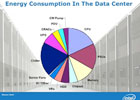Where Does All That Power Go?

This diagram illustrates how the various components in a typical data center, designed according to old practice, contribute to overall data center energy use.
The interesting, and somewhat disheartening, thing for managers and operators of old-school data centers is that of the available power from the local utility the center can only use 30% of it for the servers. This is disheartening because the IT equipment is the only part of this diagram that generates revenue or provides a service to the center's customers. The remaining 70% is nothing but an expense...and a big one at that.
That is why modern data center designs have started to use evaporative cooling or economizer cooling whenever possible. ASHRAE raised their temperature guidelines in order to keep up with the server industry that is working hard to let data center operators shift more of that wasted 70% over to the revenue producing part of the diagram. With economizer cooling almost the entire top 45% of the diagram goes away. Considering that you must still run fans to move the air into the space it is probably still safe to say that the revenue producing portion of the diagram can grow from 30% to 66%.
In many cases, though, the available outside air temperatures are just a bit too high to allow full economizer cooling. In those cases, the most energy efficient alternative is evaporative cooling. By applying evaporative cooling, rack inlet temperatures can be well within industry guidelines almost anywhere in the world...and the energy consumption is similar to the pure economizer solution.
Evaporative cooling gives the data center operator the best of both worlds...rack temperatures closer to old-school temperatures...and energy consumption closer to pure economizer solutions.
When using a fully configured evaporative cooling system from a company like Aztec the operator also gains a factory-assembled and pre-tested system that is basically "plug and play". Connecting water and power is all that is needed to get the system up and running...allowing the center to start producing revenue faster. If web-enabled communication with the Aztec unit is desired then adding the unit to a local area network can be as straight forward as adding a printer. Each unit is configured with its own IP address and the entire installation can be password protected.
